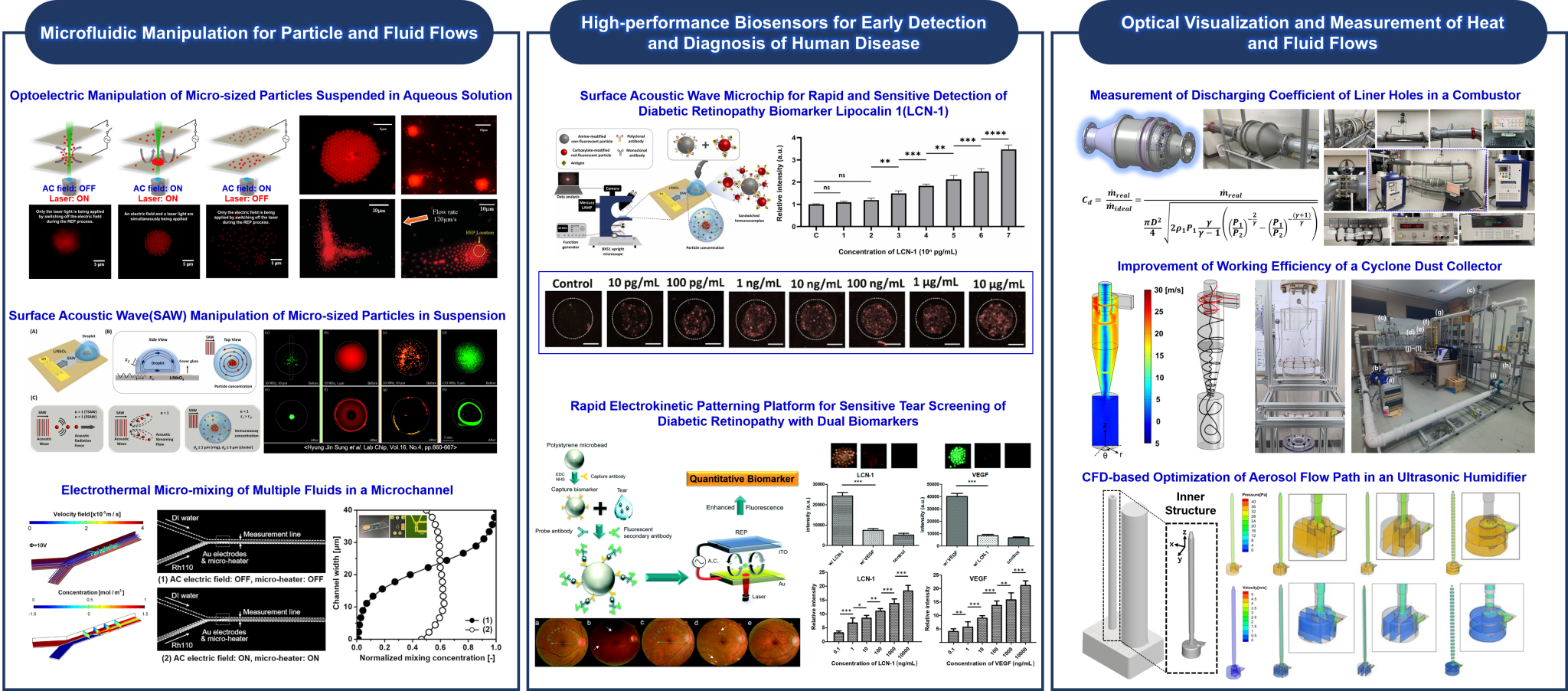Our group aims to physically analyze various particle and fluid flow phenomena that occur at nano-, micro-, and macro-scales and applies the physical insights gained from the analysis to a wide range of scientific, engineering, and industrial fields. The research areas we are pursuing are broadly divided into the following three: (1) microfluidic manipulation for particle and fluid flows, (2) high-performance biosensors for early detection and diagnosis of human disease, and (3) optical visualization and measurement of heat and fluid flows.
Microfluidic manipulation for particle and fluid flows: Microfluidics enables to precisely manipulate tiny particles and fluids at an exceedingly small scale. The powerful advantage of microfluidics has found numerous applications in the diverse fields ranging from biology and chemistry to engineering including inkjet printheads, micro-propulsion, and micro-thermal management technology. However, further enhancement and extension of the applications requires for the manipulation of particle and fluid flows to be performed in a more precise, faster, safer, more convenient-to-use, and automated manner. Whereupon, we have a high interest in exploring and developing a novel microfluidic technology for non-contact and non-invasive manipulation of micro/nano-particles and rapid transport and mixing of fluids in a miniaturized device. The developed technology will find wide applications in various scientific and industrial fields including biotechnology, replacing the existing approaches for particle and fluid flow control.
High-performance biosensors for early detection and diagnosis of human disease: Microfluidic manipulation of particle and fluid flows provides efficient tools for multiple research areas, and more specifically for biological detection and analysis. The rapid and precise patterning, trapping, sorting, and separation of micro/nano particles raise the purity of target bio-samples and which, in turn, enable the accurate and reliable analysis of the target samples within short time. Controlling fluid flow in microchannels integrated on a small chip allows on-chip performance and automation of such laborious biochemical process as sample pretreatment. Therefore, we have a high interest in development of high-performance biosensors based on the microfluidic manipulation technology. Our current research effort is focusing on demonstrating the bio-compatibility of non-invasive microfluidic manipulation techniques that we’ve developed till the present, with various bio-suspensions containing cells, viruses, fungus, bacteria, and etc. That work will lead to the on-chip realization of the microfluidic manipulation techniques for development of a high-speed and high-sensitivity biosensor and its commercialization for point-of-care diagnosis.
Optical visualization and measurement of heat and fluid flows: Visualization and measurement of fluid and heat flows is the process of observing, recording, and quantifying the complex behaviors of flowing fluids and heat. It not only enables researchers to understand various and unique physical characteristics hidden in complex heat and fluid flows but also further, helps the design optimization to improve the working performance of engineering systems involving the heat and fluid flows. For the visualization and measurement of heat and fluid flows, we have experimental equipment like particle image velocimetry (PIV) and laser doppler velocimetry (LIF), and computational fluid dynamics (CFD) simulation software like COMSOL and ANSYS. Using the experimental and numerical assets, we have improved the inner structure and outer shape, and the working performance of various fluidic systems through visualization and measurement, and modeling of heat and fluid flows involved in the systems, in the financial support of government and industries. The examples include the followings: cyclone dust collectors (supported by the Korea research foundation), dry storage casks for spent nuclear fuels (supported by the Korea foundation of nuclear safety), home appliances including a dehumidifier and air purifier (supported by the MIRO corporation), combustors of aircraft and fighter jets (supported by the Hanwha Aerospace). Our capability accumulated from the researches will continue to provide the innovative ideas for trouble-shooting in improving or developing fluidic systems.



